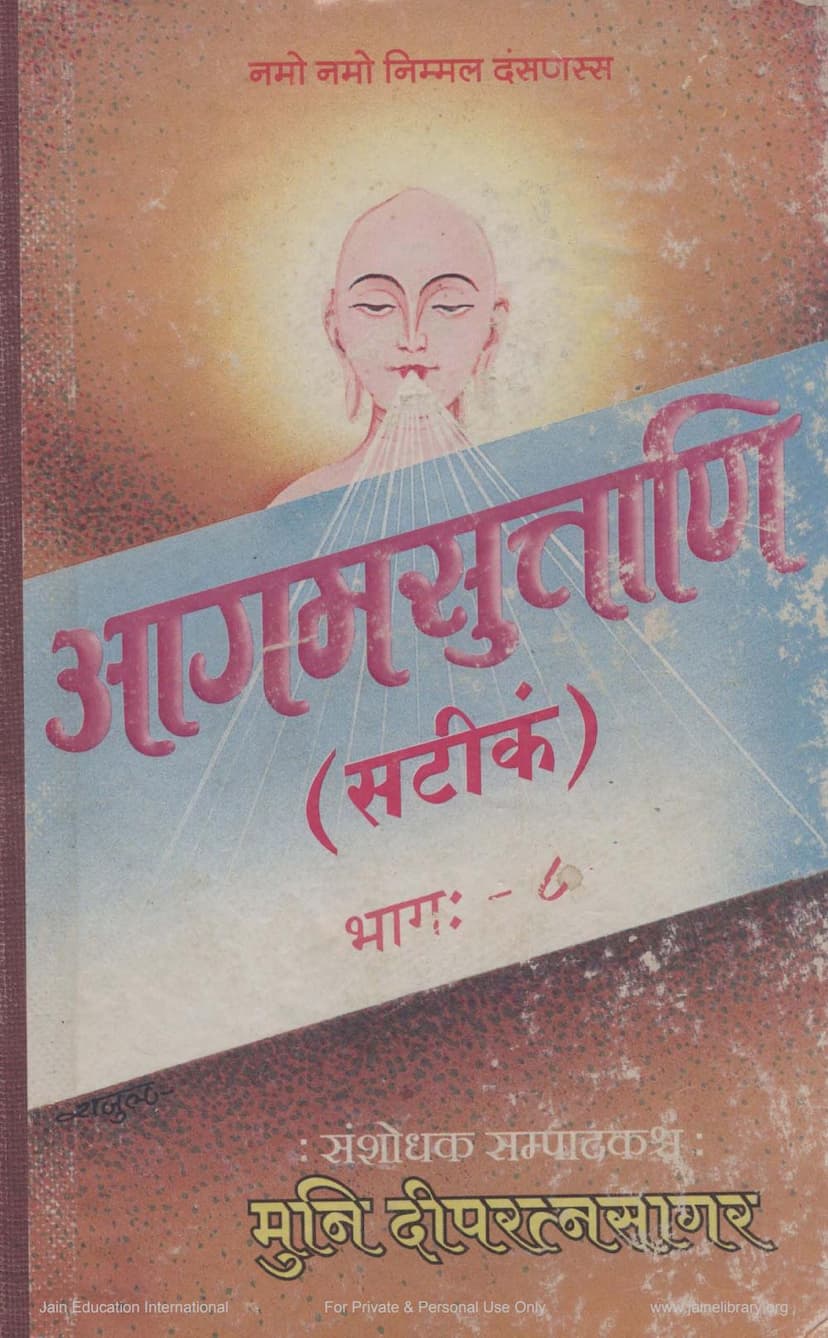Agam Suttani Satikam Part 08 Vipakshrut Auppatik Rajprashniya Sutram
Added to library: September 1, 2025

Summary
This Jain text, "Agam Suttani Satikam Part 08 Vipakshrut Auppatik Rajprashniya Sutram," authored by Dipratnasagar and published by Agam Shrut Prakashan, is a collection of three significant Jain Agam texts: Vipakashrutanga Sutra, Aupapatika Upanga Sutra, and Rajprashniya Upanga Sutra. This volume is part 8 of a larger series titled "Agam Suttani Satikam" (Agam Sutras with Commentary).
Key Texts and Their Content:
-
Vipakashrutanga Sutra (विपाकश्रुताङ्गसूत्रम्):
- This is the eleventh Anga (limb) of the Jain canon.
- As indicated by its name, "Vipakashruta," it deals with the "vipaka" or fruition of karma, specifically the consequences of meritorious (punya) and demeritorious (papa) actions.
- The text is divided into two main sections, or "Shru-t-kandhas" (श्रुतस्कन्ध):
- Shru-t-kandha 1 (श्रुतस्कन्धः-१): Focuses on the results of negative karma (duh-vipaka - दुहविवागा). It contains ten chapters (adhyayana - अध्ययन), each named after a significant individual whose life story illustrates the karmic consequences. These include:
- Mrigaputra (मृगापुत्रः)
- Ujjhitaka (उज्झितकः)
- Abhagrasena (अभग्नसेनः)
- Shakata (शकट:)
- Brihaspadatta (बृहस्पतिदत्तः)
- Nandivardhana (नन्दिवर्धनः)
- Udambara Datta (उम्बरदत्तः)
- Shaurya Datta (सौर्यदत्तः)
- Devadatta (देवदत्ता)
- Anju (अंजू)
- Shru-t-kandha 2 (श्रुतस्कन्धः-२): Focuses on the results of positive karma (suh-vipaka - सुहविवागा). It also contains ten chapters, likely illustrating the positive karmic outcomes through various lives. These chapters are named after individuals like:
- Subahu (सुबाहुः) ' Bhadranandi (भद्रनन्दी)
- Sujata (सुजातः)
- Suvasava (सुवासवः)
- Jindasa (जिनदासः)
- Dhanavati (धनवती)
- Mahabala (महाबलः)
- Bhadranandi (भद्रनन्दी) (Note: Bhadranandi appears twice, which might indicate different contexts or individuals.)
- Mahachandra (महाचंद्रः)
- Varadatta (वरदत्तः)
- Shru-t-kandha 1 (श्रुतस्कन्धः-१): Focuses on the results of negative karma (duh-vipaka - दुहविवागा). It contains ten chapters (adhyayana - अध्ययन), each named after a significant individual whose life story illustrates the karmic consequences. These include:
- The commentary ("Satika" - सटीक) by Muni Deepratnasagar aims to explain the original sutras in detail. The text provides a systematic breakdown of the subjects covered in each chapter.
-
Aupapatika Upanga Sutra (औपपातिकउपाङ्गसूत्रम्):
- This is the first Upanga Sutra.
- The term "Aupapatika" (औपपातिक) relates to "upapata," which refers to the spontaneous generation or birth of beings, particularly in celestial or infernal realms, and also the process of reaching a state of liberation or perfection. 9 The main topic discussed in this sutra, as outlined in the index, is the "Samavasarana" (समवसरण) – the divine assembly convened by a Tirthankara (like Lord Mahavira).
- The text describes various aspects of this assembly, including the city of Champanagari (चम्पा नगरी), the Purnabhadra Chaitya (पूर्णभद्रचैत्य), the grove (वनखण्डः), the Ashok tree (अशोकवृक्षः), the presence of Lord Mahavir's disciples (Mahavira's antecedents - महावीरस्य अन्तेवासी), descriptions of monks (स्थवीरवर्णन), types of austerities (तपभेदाः), the arrival of celestial beings (देवानांआगमनं), and household vows (आगारधर्म).
- It also includes the "Upapata-pada" (उपपात-पदं), which details the concept of rebirth and the spiritual states of beings, including descriptions of Gautam Ganadhara (गौतम गणधरः), Ambada Parivrajaka (अंबडपरिव्राजकः), the phenomenon of Kevali Samudghata (केवली समुद्घातः), liberated souls (सिद्धजीव), the abode of the liberated (सिद्धशीला), and the bliss of liberated souls (सिद्धजीवस्य सौख्यं).
-
Rajprashniya Upanga Sutra (राजप्रश्नीयउपाङ्गसूत्रस्य):
- This is the second Upanga Sutra.
- The name "Rajprashniya" (राजप्रश्नीय) suggests questions posed by royalty or related to royal matters.
- The index indicates two main sections:
- Suryabhadeva Prakarana (सूर्याभदेव प्रकरणं): This likely deals with the celestial being Suryabhadeva, his divine assembly (विमानसभापर्षदा), paying homage to the Lord (भगवद् वन्दनं), miracles related to his divine vehicle (दिव्यविमानविकुर्वणा), performances (नृत्यं), and the significance of images of liberated souls (सिद्धायतनः एवं जिन प्रतिमाधिकारः).
- Pradeshi Rajan Prakarana (प्रदेशिराजन्-प्रकरणं): This section focuses on King Pradeshi. It describes his encounter with Keshikumar Shraman (केशोकुमरस्य धर्मदेशना), their dialogue on dharma (प्रदेशी राजस्य केशीकुमार सार्द्ध धर्म-वार्ता), King Pradeshi's attainment of equanimity and peaceful death (प्रदेशी राज्ञस्य समाधिमरणं), and his subsequent rebirth in the Suryabhadeva heaven (सूर्याभविमाने उत्पत्ति).
Overall Significance:
This compilation provides detailed commentaries and explanations for these vital Agam texts. The Vipakashrutanga Sutra is crucial for understanding the principles of karma and its fruition, guiding adherents towards righteous conduct to achieve favorable rebirths and ultimately liberation. The Aupapatika Sutra sheds light on the cosmological aspects of Jainism, particularly the divine assemblies of Tirthankaras, and the spiritual journey of souls. The Rajprashniya Sutra delves into philosophical discussions, using the life of King Pradeshi as a case study to illustrate the path to spiritual realization and the importance of correct understanding and practice of Dharma. The commentary by Muni Deepratnasagar is instrumental in making these ancient and profound teachings accessible to contemporary readers. The publishers, Agam Shrut Prakashan, are dedicated to preserving and disseminating this valuable Jain literature.